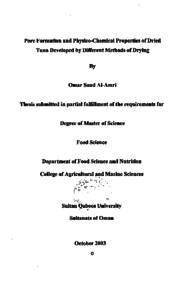وثيقة
Pore formation and physico-chemical properties of dried tuna developed by different methods of drying
الناشر
Sultan Qaboos University
ميلادي
2003
اللغة
الأنجليزية
الموضوع
الملخص الإنجليزي
In this study the characteristics of pores in dried tuna (Thunnus tongol) processed by air-, vacuum-, and freeze-drying methods were measured by mercury porosimetry, Apparent, substance and true density, porosity and pore size distributions of dried samples were measured to study the pores formed during the drying processes. The apparent density of fresh (before drying) tuna flesh was 1098 kg/m°, while the density of dried tuna by air-drying, vacuum drying, and freeze-drying were 960, 709 and 317 kg/m2, respectively. Porosity of freeze-dried sample was much higher than as I
the air-dried and vacuum-dried samples. Pores in different samples were
characterized as total intruded volume, total surface area, pore size range and average diameter, and nature of the pore size distribution curves.Peroxide value and color of dried tuna meat were also measured.
The state diagram of tuna meat was developed by measuring and modeling its glass transition temperatures and freezing points. Fresh tuna meat was dried in a freeze drier to vary the moisture content from 73.3 to 6.0% (wet basis). The glass transition temperature used in state diagram is taken from the literature. Cooling curve method was used to measure the freezing point and end point of freezing. The state diagram yielded maximally freeze-concentrated solutes at 61% solids with the characteristic temperature of glass formation being –54.2°C. The freezing curve and e-CO glass transition lines were developed by using Clausius-Clapeyron equation adjusted with un-freezable water and Gordon-Taylor models, respectively.
Water adsorption isotherms of freeze-dried tuna were measured at 0, 20, 40 and 60° C by using isopiestic method. Water sorption modeling was carried out by using Brunauer-Emmett-Teller (BET), Guggenheim-Anderson-DeBoer (GAB), and ZU Norrish models. BET and GAB monolayer moisture contents were varied from 4.46 to 6.10% and 4.34 to 9.44% (dry basis) respectively, when temperature varied from 60 to 0°C. Net isosteric heat of sorption, determined from the Clausius-Clapeyron
equation was found to vary from 4.491 to -0.016 kJ/g mol when moisture content was changed from 5% to 90% (dry basis).
الوصف
Thesis
المجموعة
URL المصدر
الملخص العربي
تم في هذه الدراسة قياس ميزات المسام في التونة (السهوة المجففة (Thunnus tongol) بوجود الهواء وتحت التفريغ و التجنيد التجفيف بالتجميد) باستخدام Porosimetry الزئبقي. تم قياس الكثافة الظاهرة و كثافة المادة و الكثافة الحقيقية و المسامية و توزيع احجام المسام لدراسة تكون المسامات أثناء عمليات التجفيف. الكثافة الظاهرة للتونة الطازجة ( قبل التجفيف ) 1098 كج / م3 ، بينما كانت كثافة التونة المجقفة بالهواء( air - drying ) و التفريغ ( vacuum - drying ) و التجفيدر -freeze drying) 960 ، 709 و 317 كجم، على التوالي. كانت مسامية العينة المجفدة أعلى كثيرا من المجففة هوائيا و العينات المجففة بالتفريغ. لقد صنف المسام في العينات المختلفة على حسب الكمية المتطفلة الكلية ، المساحة الكلية، مدى حجم المسام و القطر العادي، و طبيعة منحنيات توزيع حجم المسام. تم قياس أيضا قيمة البيروكسيد و لون لحم التونة المجقف طور الرسم البياني للحالمة في لحم التونة بقياس و تصميم درجات حرارة الانتقال إلى المستوى الزجاجي و نقاط التجمد. كما تم تجفيف لحم التونة الطازجة في المجفد لتنويع محتوى الرطوبة من 73 . 3) إلى 6 (% أساس رطب. تم أخذ درجة حرارة الانتقال إلى المستوى الزجاجي المستخدم في الرسم البياني للحالة من المرجع. استخدمت طريقة منحنى التبريد لقياس نقطة التجمد و نهاية التجمد. أنتج الرسم البياني للحالة تكون منطقة التجمد المتركزة الأقصى للمذابات عند61 % صلب و الحرارة المميزة لتكوين الزجاج عند 54 , 2°C طور منحنى التجمد و درجة حرارة الانتقال إلى المستوى الزجاجي باستخدام معادلة Clausius - Clapeyron مع تكيفها بالماء الغير قابل للتجمد و نماذج Gordon - Taylor على التوالي. تم قياس نشاط الامتصاص المائي على درجات حرارة 0 و 20 و 40 و 60 درجة حرارة منوية لسمك التونة المجففة باستخدام التجويد freeze drying تحت ضغط ثابت. لقد تم أستخدم نماذج (Burnauer Emmett Teller (BET), Guggenheim Anderson deBoer (GAB) and Norrish models)
التخطيط الامتصاص المائي. تفاوتت محتويات الرطوبة للطبقة الأحادية المستخدمة بطريقة BET و GAB بين) 4 . 46 إلى 6 . 10 % و 4 . 34 إلى 9 . 44 % ( اساس جافة على التوالي و ذلك عندما تغيرت الحرارة من 60 إلى 0 درجة حرارة مئوية. لقد تم تقدير الامتصاص الحراري تحت ضغط ثابت بواسطة Clausius Clapeyron equation ، حدث التغير من 4 . 491 إلى 0 . 016- ك جول /ج مول عندما تغير محتوى الرطوبة من 5 % إلى 90 % أساس جافة.
التخطيط الامتصاص المائي. تفاوتت محتويات الرطوبة للطبقة الأحادية المستخدمة بطريقة BET و GAB بين) 4 . 46 إلى 6 . 10 % و 4 . 34 إلى 9 . 44 % ( اساس جافة على التوالي و ذلك عندما تغيرت الحرارة من 60 إلى 0 درجة حرارة مئوية. لقد تم تقدير الامتصاص الحراري تحت ضغط ثابت بواسطة Clausius Clapeyron equation ، حدث التغير من 4 . 491 إلى 0 . 016- ك جول /ج مول عندما تغير محتوى الرطوبة من 5 % إلى 90 % أساس جافة.
قالب العنصر
الرسائل والأطروحات الجامعية

